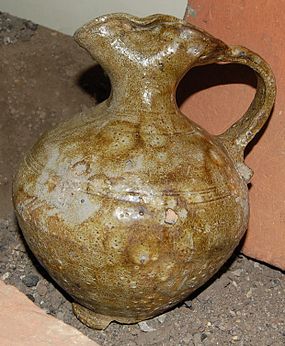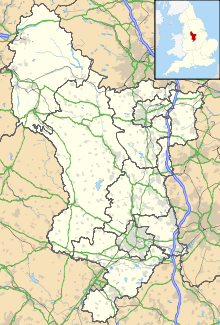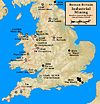- Derby Racecourse Roman settlement
-
Derby Racecourse Roman settlement 
A Green Glazed Jug from the Racecourse settlement Map showing the location of Derventio within Derbyshire.Location Derby, Derbyshire Region East Midlands Coordinates 52°56′01″N 1°28′25″W / 52.933735°N 1.473586°W Type Roman fort Part of Icknield Street History Founded 120 Site notes Website roman-britain.org/places/derventio coritanorum.htm Pastscape The Derby Racecourse Roman settlement was the third settlement in Derby or Derventio was a small town in the Roman province of Britannia. It lies 600m east of Derventio fort in Little Chester, on the outskirts of Derby, in the English county of Derbyshire.[1] The Roman road from Derventio to Sawley on the River Trent passes the settlement. It is a scheduled National Monument.
Contents
Description
The first Roman fort in the area was built on the opposite bank of the River Derwent at Strutts Park. It was replaced about AD 80 by a fort at Little Chester, but this only lasted about forty years, then decommissioned. The fort was later re-occupied and re-used for a further twenty five years then unoccupied until the late 3rd century when a stone wall was built around the town. [2] There is evidence of extensive Roman activity in Little Chester. Derby Racecourse Roman settlement site was founded around AD 90.[3] It is considered by English Heritage to be an import example of a fort-vicus. This was a civilian settlement attached to a Roman military fort- in this case Derventio. It is a mark that the Cornovii tribesmen were accepting the Roman way of life and integrating themselves into the Roman economy- ie Romanisation. [4]
Pottery kilns have been discovered dating from AD90 to the mid second century when ironworking took place. The jug illustrated was fired at this settlement and is now in Derby Museum. There was also a large cemetery with five stone mausolea. [5]
History
Main article: Roman conquest of BritainThis part of Britannica[clarification needed] was occupied by a tribe known as the Cornovii. In AD 46-47 the Roman Army under the direction of governor Aulius Plautius had probably occupied the lands to the south of the River Trent, so in AD 50 this was the front line. There is a shortage of written documentation about these years so reliance is made on archaeological excavations. Late in 47 the new governor of Britain, Ostorius Scapula, began a campaign against the tribes of modern day Wales, and the Cheshire Gap. During these times Strutts Park Roman fort, was one of the new forts built along the new supply road from Wroxeter to Rossington.
The campaign to conquer the Silures continued under the governor Quintus Veranius and his successor Gaius Suetonius Paulinus but by now Strutt Park's rôle was to maintain the peace. Around AD 74, the lands north of the River Mersey became unstable, when Queen Cartimandua had to ask for Roman assistance to fight off a rebellion. Then in AD78, Gnaeus Julius Agricola, made famous through the highly laudatory biography of him written by his son-in-law, Tacitus, was made governor. He consolidated the forts, improved the road infrastructure and led some now well documented campaigns- firstly in AD78, he reconquered North Wales, then in AD79 he conquered the Brigantes and Parisii taking all of Northern England up to the present Scottish border. Strutt's Park fort was vacated in AD 80 when Derventio was built.
The Emperor Hadrian visited Britannia in AD120 and ordered his wall to be built. Though Britannia always had a large garrison, focus now changed to industrial production. Derby produced pottery and had access to the lead mining to the north in the Peak District, later it became a centre for metalworking. This continued for the next 200 years.
References
- ^ Burnham, Barry C; Wacher, John (1990). The Small Towns of Roman Britain. London: B T Batsford. ISBN 9780520073036.
- ^ Vinnels, Maria (2006-06-15). "Manor Kingsway SPD Derby". White Young Green Envronment Ltd for English Heritage. http://eplanning.derby.gov.uk/acolnet/DocumentsOnline/documents/23924_33.pdf. Retrieved 2011-07-25.
- ^ "Roman industrial site on Derby Racecourse". Pastscapes. English Heritage. http://www.pastscape.org.uk/hob.aspx?hob_id=313342. Retrieved 2011-07-25.
- ^ "Derby Racecourse Roman vicus & cemetry". Derby City Council. http://www.derby.gov.uk/NR/rdonlyres/CF205AE5-D534-494F-A195-8438B8027BD6/0/P_DerbyRacecourseRomanvicuscemetery1.pdf. Retrieved 23 May 2011.
- ^ Clay, Patrick; Sam George (2008). "An Archaeological Desk-Based Assessment for Proposed Development at the former Union Iron Foundry, City Road, Derby (SK 353 372)". University of Leicester Archaeological Services. http://eplanning.derby.gov.uk/acolnet/DocumentsOnline/documents/25607_4.pdf. Retrieved 2011-07-25.
External links
- "Archaeology and Scheduled Ancient Monuments in Derby". Derby City Council. http://www.derby.gov.uk/Environment/Planning/builtheritage/Archaeology_and_Scheduled_Ancient_Monuments_in_Derby.htm. Retrieved 2011-07-25.
- "Little Chester / Chester Green". Discover Derbyshire and the Peak District. http://www.derbyshire-peakdistrict.co.uk/derbylittlechester.htm. Retrieved 2011-07-25.
- "Derventio Heritage Village". Discover Derbyshire and the Peak District. http://www.derbyshire-peakdistrict.co.uk/derventio.htm. Retrieved 2011-07-25.
- "Derventio Coritanorvm". Roman Britain Organisation. 2004. http://www.roman-britain.org/places/derventio_coritanorum.htm. Retrieved 2011-07-25.
- "Derventio Roman Fort". Pastscapes. English Heritage. http://www.pastscape.org.uk/hob.aspx?hob_id=313283. Retrieved 2011-07-25. ,
- "Roman Pottery Bibliography - Derbyshire". Study Group for Roman Pottery. 2008-02-27. http://www.sgrp.org.uk/12/DBY/00.htm. Retrieved 2011-07-25.
- Andrew Myers (2000). "An Archaeological Resource Assessment of Roman Derbyshire" (PDF). Derbyshire County Council. http://www.le.ac.uk/ulas/publications/documents/21derrom_000.pdf. Retrieved 2011-07-25. - East Midlands Archaeological Research Framework
Bibliography
- M. Brassington (1971). "A Trajanic kiln-complex near Little Chester, Derby". Antiquaries Journal 51: 36–69.
- M. Brassington (1981). The Roman roads of Derby. 101. 88–92.
- M. Dearne (1991). "The military vici of the South Pennines: retrospect and prospect". In R. Hodges, K. Smith. Recent Developments in the Archaeology of the Peak District. Sheffield: Sheffield University Press. pp. 69–84. ISBN 978-0906090381.
- J. Dool, H. Wheeler et al. (1986). "Roman Derby - Excavations 1968-1983". Derbyshire Archaeological Journal 105, 1985.
- J. Dool (1986). "Roman Derby - Excavations 1968-1983". Derbyshire Archaeological Journal 105, 1985: 155–221. - "Derby Racecourse: Excavations on the Roman Industrial Settlement, 1974"
- Vivien G. Swan (1984). The Pottery Kilns of Roman Britain. London: Royal Commission on the Historical Monuments of England. ISBN 978-0117012035.
Derby Museum and Art Gallery Artists Francis Leggatt Chantrey · Ernest Ellis Clark · W. J. Coffee · Derby Sketching Club · Harold Gresley · Count Holtzendorff · Alfred John Keene · Henry Lark Pratt · David Payne · Ronald Pope · Samuel Rayner · Louise Rayner · Thomas Smith · Ernest Townsend · George Turner · Joseph Wright of DerbyGeology Ashford Black Marble · John Farey · William Martin · Matlockite · John Mawe · White Watson · John WhitehurstDecorative arts Bonnie Prince Charlie RoomMilitary history 9th/12th Royal Lancers · William Goate · Robert Kells · Francis O. Grenfell · David Rushe · David Spence · Gen. Johnson Saving Officer from TomahawkNatural history Paintings & drawings Richard Arkwright · Orrery · Indian Widow · Romeo and Juliet · Miravan · Alchemist · Virgil's Tomb · Blacksmith's Shop · Earthstopper · A Philosopher by Lamplight · Samuel Ward · Captive · Captive King · Dovedale · Thomas and Ann Borrow · VesuviasPorcelain Chelsea porcelain factory · Derby porcelain · Royal Crown Derby · Pinxton Porcelain · André Planché · William Billingsley · William DuesburyAncient Britain Creswellian culture · Derventio · Strutt's Park Roman fort · Derby Racecourse Roman settlement · Hanson Log Boat · Great Heathen Army · Heath Wood barrow cemetery · Codnor Castle · Duffield Castle · Icknield St. · The Street · The Long LaneScience & engineering Atlas Coelestis · Benjamin Vulliamy Whitehurst & Son sundial · QRpediaRelated OrganisationsAndrew Handyside & Co. · British Rail Research Division · Derby Philosophical Society · Derby Exhibition (1839)PeopleAlchmund · P.P.Burdett · D'Ewes Coke · Erasmus Darwin · 6th Duke of Devonshire · James Ferguson · R.K.Freeman · Alfred E. Goodey · Sir George Harpur Crewe · Llewellyn Jewitt · John Lombe · William Mundy · Joseph Pickford · 5th Earl Ferrers · George Sorocold · Joseph Strutt · Charles SylvesterDerby Silk Mill (Lombe's Mill) · Pickford's House Museum · Central Library Categories:- Roman Derby
- Roman towns and cities in England
- Former populated places in England
Wikimedia Foundation. 2010.



